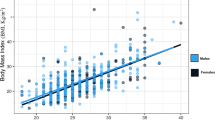Abstract
Background
Upper arm composition is a reflection of body protein and calorie reserves. However, there is a paucity of data on upper arm composition of children from African countries, including Nigeria. This study aimed to determine the composition of upper arm and nutritional status of school children in Abeokuta, Nigeria and to compare with international reference standards. The sensitivity and specificity of upper arm muscle area by height (UAMAH) as a nutritional assessment tool was also determined.
Methods
Five hundred and seventy children aged 5 to 19 years were selected from seven schools using multistage random sampling. Weight, height, mid-upper arm circumference (MUAC) and triceps skin fold thickness (TSF) were measured. Body mass index, upper arm muscle area (UAMA), upper arm fat area (UAFA), fat percentage and UAMAH were derived.
Results
The TSF, UAFA and fat percentage were significantly higher in females than males at each age group. MUAC and UAMA were significantly higher in female children aged 10–14 years, whereas UAMA was significantly higher in male children aged 15–19 years. UAMA and UAFA of the children were lower than those of Americans but similar to those of Zimbabweans, and higher than those of Indians. The sensitivity and specificity of UAMAH for detecting wasting were 80.8% and 63.9%, respectively, whereas the corresponding values for stunting were 32.2% and 58.2%, respectively.
Conclusions
The school children studied have a combination of poor calorie and protein reserve. UAMAH may be a valuable tool for complete evaluation of the nutritional status of school children.
Similar content being viewed by others
References
Black RE, Allen LH, Bhutta ZA, Caulfield LE, de Onis M, Ezzati M, et al. Maternal and child undernutrition: global and regional exposures and health consequences. Lancet 2008;371:243–260.
World Health Organization. Consultation on nutrition and HIV/AIDS in Africa. Evidence, lessons and recommendations for action. Geneva: World Health Organization, 2005.
Ayoola O, Ebersole K, Omotade OO, Tayo BO, Brieger WR, Salami K, et al. Relative height and weight among children and adolescents of rural southwestern Nigeria. Ann Hum Biol 2009;36:388–399.
Ivanovic DM, Pérez HT, Olivares MG, Díaz NS, Leyton BD, Ivanovic RM. Scholastic achievement: a multivariate analysis of nutritional, intellectual, socioeconomic, sociocultural, familial, and demographic variables in Chilean school-age children. Nutrition 2004;20:878–889.
Monyeki KD, Monyeki MA, Bits SJ, Kemper HCG, Makgae PJ. Development and tracking of body mass index from preschool age into adolescence in rural South African children: Ellisras longitudinal growth and health study. J Health Popul Nutr 2008;26:405–417.
Senbanjo IO, Oshikoya KA, Odusanya OO, Njokanma OF. Prevalence of and risk factors for stunting among school children and adolescents in Abeokuta, southwest Nigeria. J Health Popul Nutr 2011;29:364–370.
Ben-Bassey UP, Oduwole AO, Ogundipe OO. Prevalence of overweight and obesity in Eti-Osa LGA, Lagos, Nigeria. Obes Rev 2007;8:475–479.
Frisancho AR. Triceps skin fold and upper arm muscle size norms for assessment of nutrition status. Am J Clin Nutr 1974;27:1052–1058.
Frisancho AR. New norms of upper limb fat and muscle areas for assessment of nutritional status. Am J Clin Nutr 1981;34:2540–2545.
Deurenberg P, Pieters JJ, Hautvast JG. The assessment of the body fat percentage by skinfold thickness measurements in childhood and young adolescence. Br J Nutr 1990;63:293–303.
Frisancho AR, Tracer DP. Standards of arm muscle by stature for the assessment of nutritional status of children. Am J Phys Anthropol 1987;73:459–465.
Oyedeji GA. Socioeconomic and cultural background of hospitalized children in Ilesa. Nig J Paediatr 1985;12:111–117.
Monir Z, Koura M, Erfan M, Abd El Aziz A, Mansour M. Anthropometric parameters in relation to nutritional status in school children. Egypt Med J NRC 2004;5:15–39.
World Health Organization expert committee. 1995. Physical status, the use and interpretation of anthropometry. WHO technical report series 1995;894:424–438.
Sen J, Mondal N, Dey S. Assessment of the nutritional status of children aged 5–12 years using upper arm composition. Ann Hum Biol 2011;38:752–759.
Ozturk A, Budak N, Cicek B, Mazicioglu MM, Bayram F, Kurtoglu S. Cross-sectional reference values for mid-upper arm circumference, triceps skinfold thickness and arm fat area of Turkish children and adolescents. Int J Food Sci Nutr 2009;60:267–281.
Olivieri F, Semproli S, Pettener D, Toselli S. Growth and malnutrition of rural Zimbabwean children (6–17 years of age). Am J Phys Anthropol 2008;136:214–222.
Boyne MS, Thame M, Osmond C, Fraser RA, Gabay L, Reid M, et al. Growth, body composition, and the onset of puberty: longitudinal observations in Afro-Caribbean children. J Clin Endocrinol Metab 2010;95:3194–3200.
He Q, Horlick M, Thornton J, Wang J, Pierson RN, Heshka S, et al. Sex and race differences in fat distribution among Asian, African-American, and Caucasian prepubertal children. J Clin Endocrinol Metab 2002;87:2164–2170.
Wang T, Hung CC, Randall DJ. The Comparative Physiology of Food Deprivation: From Feast to Famine. Annu Rev Physiol 2006;68:223–251.
Derman O, Yalcin SS, Kanbur N, Kinik E. The influence of the sexual stages of adolescent boys on the circumference of the arm, muscle area and skin-fold measurements. Int J Adolesc Med Health 2002;14:19–26.
Chowdhury SD, Ghosh T. The upper arm muscle and fat area of Santal children: an evaluation of nutritional status. Acta Paediatr 2009;98:103–106.
Al-Sendi AM, Shetty P, Musaiger AO. Anthropometric and body composition indicators of Bahraini adolescents. Ann Hum Biol 2003;30:367–379.
Senbanjo IO, Njokanma OF, Oshikoya KA. Waist circumference values of Nigerian children and adolescents. Ann Nutr Metab 2009;54:145–150.
López-Contreras de Blanco M. Muscle and fat indicators in boys of the upper socioeconomic strata of Caracas. Arch Latinoam Nutr 1988;38:815–833.
Author information
Authors and Affiliations
Corresponding author
Rights and permissions
About this article
Cite this article
Senbanjo, I.O., Oshikoya, K.A. & Njokanma, O.F. Upper arm composition and nutritional status of school children and adolescents in Abeokuta, Southwest Nigeria. World J Pediatr 10, 336–342 (2014). https://doi.org/10.1007/s12519-014-0470-4
Received:
Accepted:
Published:
Issue Date:
DOI: https://doi.org/10.1007/s12519-014-0470-4




